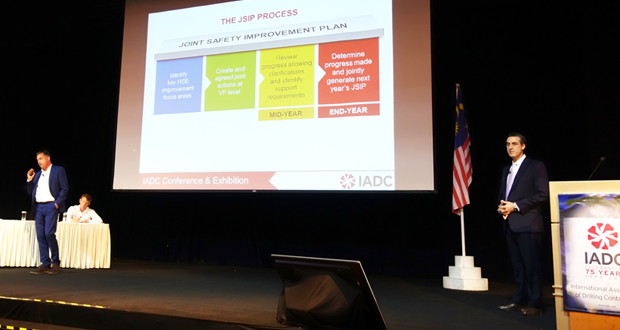Joint safety improvement plan aligns HSE objectives, “language” for Shell, Halliburton

By Astrid Wynne, Contributing Editor

Speaking at a joint presentation with Halliburton at the 2015 IADC HSE&T Asia Pacific Conference in Kuala Lumpur on 12 March, Alain Moonen, Manager Wells Safety at Shell, noted that the industry’s safety performance is tailing off even though we are still going in the right general direction. “It’s unacceptable that we create an environment where people still get hurt,” he said. Together with Duane Sherritt, VP Business Development Asia Pacific at Halliburton, Mr Moonen shared the results of a joint safety improvement plan (JSIP) put in place between Haliburton and Shell in the Asia Pacific region.
JSIPs are an initiative Shell began four years ago in collaboration with several of the company’s business partners. They are jointly created between operator and contractor and work to align and formalize the key HSE focus areas in both personal and process safety. While most companies have the same objectives when it comes to HSE, as well as similar procedures, Mr Moonen explained, the JSIPs are intended to help put those things in the same “language.” Resulting procedures and collaterals will look the same, feel the same and follow the same direction. “It’s very simple, but it’s focused and aligned,” he said.
Mr Sherritt explained that, with this kind of parallel approach, teams who had never worked together before are enabled to take a proactive approach to preventing risk for themselves and those around them. “By having a common language, our employees not only understand the expectations of the client but are actually able to participate in them,” he said.
For this project, Shell and Halliburton co-developed key business and HSE initiatives that integrated the JSIP with business improvement plans and contract management plans. In the beginning stages, the companies jointly identified key HSE improvement areas and created joint actions. The plan is then reviewed yearly to assess its effectiveness and to build on improvements.
“Around mid-year we sit together again, hold a little mirror up to ourselves and say, ‘Hey, we are both committed to this, but is this really the right direction?’ ” Mr Moonen said. Dialogue continues at the end of the year when the companies come together to see if they have achieved a step-change and to formulate the JSIP for the following year.
The JSIP begins with an agreement on key areas of policy agreed to by both parties. These cover areas like leadership visits, process safety, dropped object prevention, management of change, assist and assure, and emergency repsonse. This list is signed at a VP level.
“That’s extremely meaningful for us because we are focused on how we are going to manage our people, where our investments for HSE are going to be,” Mr Sherritt said.
The high-level agreement on corporate initiatives is followed by alignment on life rules and critical focus areas on process and personnel safety that relate to the life of the well. Each company then uses this to generate materials used at ground level. For personal safety, Halliburton’s 10 to Zero Life Rules echo Shell’s 12 Life Saving Rules, the only difference being that smoking and alcohol/ drug use prohibitions are part of the employee handbook at Halliburton. For process safety, Shell’s Critical Elements match the material set out in the Halliburton Process Safety Toolkit.
Mr Sherritt said that this helps the company to understand the metrics involved and how they are going to be measured. It also helps to acquire a heightened level of awareness during management assessments and gives the contractor clear buy-in from the client to stop work by anyone whenever necessary.
Results so far are encouraging. For the year of 2014 and the first months of 2015, joint projects in the Asia Pacific region between Shell and Halliburton have achieved zero incidents. Mr Sherritt said, “Zero is possible, but it’s not a journey you can take alone. If we come together, we can have alignment.”





It is proven that management commitment in safety helps reducing numbers of HSE related incidents tremendously. Commitment is not only lead by example but providing required tools and competencies for employees to work safely at all time.